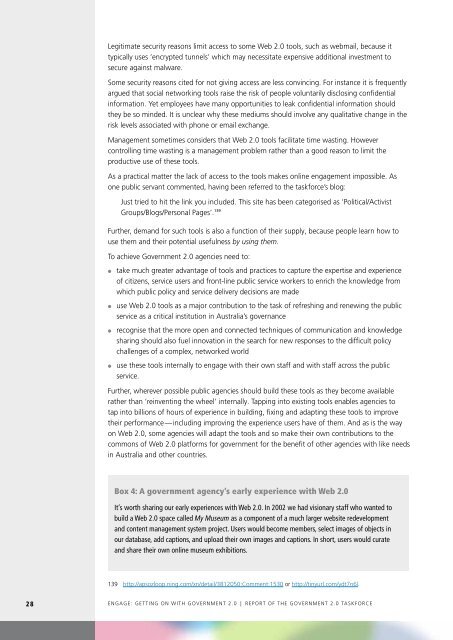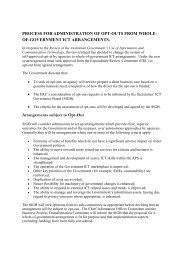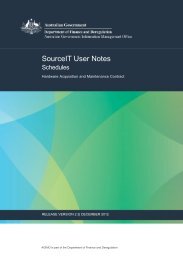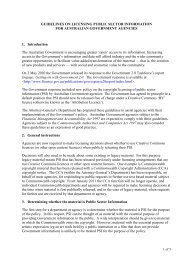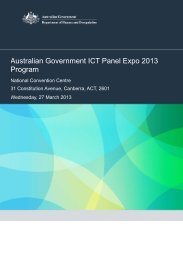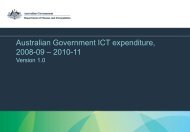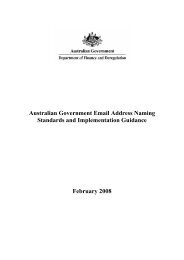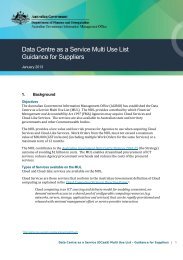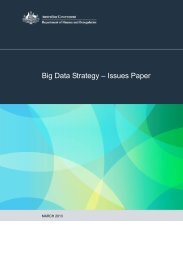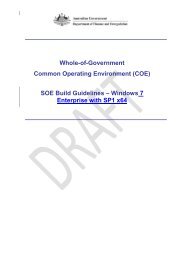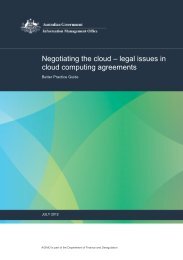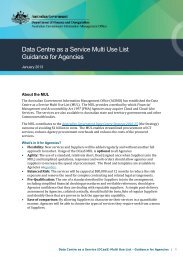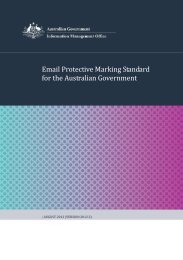Getting on with Government 2.0 - Department of Finance and ...
Getting on with Government 2.0 - Department of Finance and ...
Getting on with Government 2.0 - Department of Finance and ...
Create successful ePaper yourself
Turn your PDF publications into a flip-book with our unique Google optimized e-Paper software.
Legitimate security reas<strong>on</strong>s limit access to some Web <strong>2.0</strong> tools, such as webmail, because it<br />
typically uses ‘encrypted tunnels’ which may necessitate expensive additi<strong>on</strong>al investment to<br />
secure against malware.<br />
Some security reas<strong>on</strong>s cited for not giving access are less c<strong>on</strong>vincing. For instance it is frequently<br />
argued that social networking tools raise the risk <strong>of</strong> people voluntarily disclosing c<strong>on</strong>fidential<br />
informati<strong>on</strong>. Yet employees have many opportunities to leak c<strong>on</strong>fidential informati<strong>on</strong> should<br />
they be so minded. It is unclear why these mediums should involve any qualitative change in the<br />
risk levels associated <strong>with</strong> ph<strong>on</strong>e or email exchange.<br />
Management sometimes c<strong>on</strong>siders that Web <strong>2.0</strong> tools facilitate time wasting. However<br />
c<strong>on</strong>trolling time wasting is a management problem rather than a good reas<strong>on</strong> to limit the<br />
productive use <strong>of</strong> these tools.<br />
As a practical matter the lack <strong>of</strong> access to the tools makes <strong>on</strong>line engagement impossible. As<br />
<strong>on</strong>e public servant commented, having been referred to the taskforce’s blog:<br />
Just tried to hit the link you included. This site has been categorised as ‘Political/Activist<br />
Groups/Blogs/Pers<strong>on</strong>al Pages’. 139<br />
<br />
Further, dem<strong>and</strong> for such tools is also a functi<strong>on</strong> <strong>of</strong> their supply, because people learn how to<br />
use them <strong>and</strong> their potential usefulness by using them.<br />
To achieve <strong>Government</strong> <strong>2.0</strong> agencies need to:<br />
●●<br />
●●<br />
●●<br />
●●<br />
take much greater advantage <strong>of</strong> tools <strong>and</strong> practices to capture the expertise <strong>and</strong> experience<br />
<strong>of</strong> citizens, service users <strong>and</strong> fr<strong>on</strong>t-line public service workers to enrich the knowledge from<br />
which public policy <strong>and</strong> service delivery decisi<strong>on</strong>s are made<br />
use Web <strong>2.0</strong> tools as a major c<strong>on</strong>tributi<strong>on</strong> to the task <strong>of</strong> refreshing <strong>and</strong> renewing the public<br />
service as a critical instituti<strong>on</strong> in Australia’s governance<br />
recognise that the more open <strong>and</strong> c<strong>on</strong>nected techniques <strong>of</strong> communicati<strong>on</strong> <strong>and</strong> knowledge<br />
sharing should also fuel innovati<strong>on</strong> in the search for new resp<strong>on</strong>ses to the difficult policy<br />
challenges <strong>of</strong> a complex, networked world<br />
use these tools internally to engage <strong>with</strong> their own staff <strong>and</strong> <strong>with</strong> staff across the public<br />
service.<br />
Further, wherever possible public agencies should build these tools as they become available<br />
rather than ‘reinventing the wheel’ internally. Tapping into existing tools enables agencies to<br />
tap into billi<strong>on</strong>s <strong>of</strong> hours <strong>of</strong> experience in building, fixing <strong>and</strong> adapting these tools to improve<br />
their performance — including improving the experience users have <strong>of</strong> them. And as is the way<br />
<strong>on</strong> Web <strong>2.0</strong>, some agencies will adapt the tools <strong>and</strong> so make their own c<strong>on</strong>tributi<strong>on</strong>s to the<br />
comm<strong>on</strong>s <strong>of</strong> Web <strong>2.0</strong> platforms for government for the benefit <strong>of</strong> other agencies <strong>with</strong> like needs<br />
in Australia <strong>and</strong> other countries.<br />
Box 4: A government agency’s early experience <strong>with</strong> Web <strong>2.0</strong><br />
It’s worth sharing our early experiences <strong>with</strong> Web <strong>2.0</strong>. In 2002 we had visi<strong>on</strong>ary staff who wanted to<br />
build a Web <strong>2.0</strong> space called My Museum as a comp<strong>on</strong>ent <strong>of</strong> a much larger website redevelopment<br />
<strong>and</strong> c<strong>on</strong>tent management system project. Users would become members, select images <strong>of</strong> objects in<br />
our database, add capti<strong>on</strong>s, <strong>and</strong> upload their own images <strong>and</strong> capti<strong>on</strong>s. In short, users would curate<br />
<strong>and</strong> share their own <strong>on</strong>line museum exhibiti<strong>on</strong>s.<br />
139 http://apsozloop.ning.com/xn/detail/3812050:Comment:1530 or http://tinyurl.com/ydt7n6l.<br />
28<br />
Engage: <str<strong>on</strong>g>Getting</str<strong>on</strong>g> <strong>on</strong> <strong>with</strong> <strong>Government</strong> <strong>2.0</strong> | report <strong>of</strong> the government <strong>2.0</strong> taskforce


